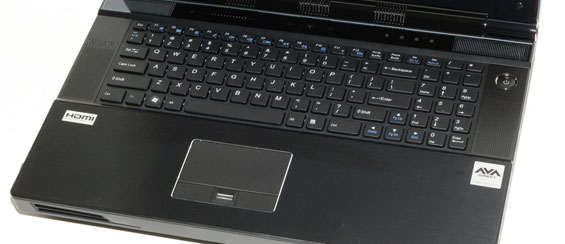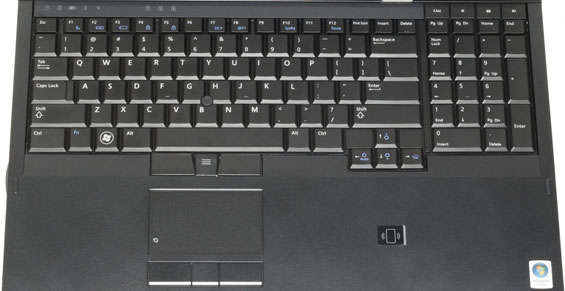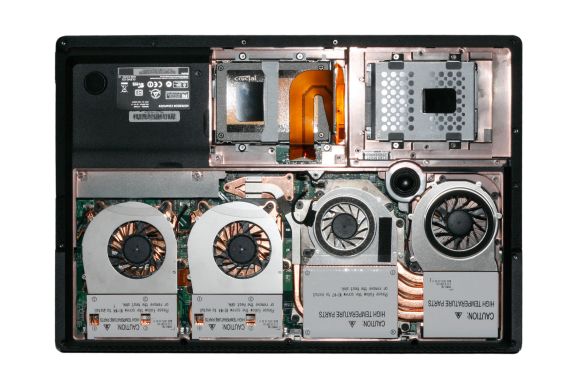AVADirect Clevo X7200: Six Cores, SSD RAID, and GTX 480M SLI Yields World's Fastest DTR Notebook
by Jarred Walton on October 7, 2010 12:30 AM ESTClevo X7200: Digging Deeper
As we mentioned, this is the nicest looking Clevo unit we've ever seen. It's still big and heavy, but the aluminum panels in place of glossy plastic are greatly appreciated. It's unfortunate that Clevo continues to use a glossy plastic bezel around the LCD—the one place where you're practically guaranteed to get fingerprints whenever you open the system. Even with a few minor blemishes, though, the X7200 is a clear improvement on previous designs.
The LCD boasts a good contrast ratio but it's not particularly bright. We've seen this same LCD in the ASUS G73Jh, as well as the Clevo W880CU. It uses CCFL backlighting and produces good colors overall, but still falls far short of a good desktop LCD. Clevo lists a 120Hz 1080p 3D LCD as an optional upgrade, though at present that's missing from the AVADirect configurator. We'd really like to see what the 120Hz panel is like, because hopefully it can boost the brightness without sacrificing contrast, and 120Hz signals are nice even if you never run a 3D movie or game. Considering all the other features, we would have liked to see keyboard backlighting, and the blue glowing strip in the touchpad seems less important than glowing keys, particularly if you're ever interested in attending a LAN party.
With all the other improvements, it's a crying shame that Clevo still can't be bothered to fix their lamentable keyboard layout. Seriously, look at the number keypad and cursor keys.

The decimal point, plus, and minus keys are in a location that differs from every full size keyboard on the planet, and it's not as if they don't have enough room to fix the layout. There's easily an inch and a half on the right and left sides of the keyboard that could be put to good use with a better layout. Once again Clevo trots out the same old tired keyboard design, with [Fn + cursor] key combinations required to use the Home, End, PgUp, and PgDn keys—or you could disable numlock and find those keys on the number keypad. Simply put, neither solution is remotely acceptable in a high-end desktop replacement with plenty of room. I'm not sure how to get through to Clevo on this one, but your keyboard layout is garbage and needs a change! Here's a simple solution, taken from Dell's Precision M6500:

See how easy it would be to fit that into the 17" and larger Clevo designs? See how Dell manages to put a normal 10-key in there, with cursor keys slightly offset so you don't accidentally hit the right arrow when you're looking for the zero, or the enter key when you're going for the decimal point? I don't know if there are a bunch of Clevo users out there that love the current layout, but for me it's a low point on every Clevo based laptop I test. People are paying well over two grand for these systems, and we're talking about a change that should cost a small amount of "R&D" at best. Granted, Clevo has keyboard layouts for quite a few languages, but I'm betting they all have the same layout issues as the US version.
Dustin went off on the Acer/Gateway keyboard and the "floating island" keys a couple weeks back, but for my money I'd say this is the more egregious sin. Gateway and Acer laptops are at least value propositions, but this is a bucket load of cash for something just as bad. If you never use the 10-key or the Home/End and PgUp/PgDn keys, the keyboard action is fine and represents typical chiclet designs, but on a mobile workstation I'd want to use both the 10-key and the page navigation keys. (I do miss the context-menu key on the Dell, however... it's something I use but I'm not sure anyone else does. That's easy enough to correct, of course.)
Incidentally, I did a 10-key typing test just to see how bad the layout affects me. The verdict: I key in numbers (with decimal points and mathematical operators) three times as slow and I'm about five times more likely to make an error! I could probably improve after a while, but I can never see myself using this 10-key at anything approaching a normal speed—especially if I continue to use regular desktop keyboards on a regular basis. Thankfully at least there's not a bunch of flex in the keyboard to really push me over the edge, but for a high-end notebook the keyboard is at best merely average. But enough about the keyboard, let's look at the internals.
Getting at the insides of the X7200 isn't too hard, though there are four different areas you can access. For the main CPU and GPU area, you remove the single large access plate on the bottom. That gets you a nice view of the four gigantic blower fans and heatsinks for the CPU, chipset, and GPUs. A smaller plate lets you get at the double HDD bay (occupied by the two C300 SSDs in our system), and the battery needs to come out if you want to get at the third hard drive slot. As for the memory, to upgrade RAM you'll need to remove the keyboard—a bit more of a pain in the rear than some of the other laptops.
What we'd really like to see is the ability to upgrade GPUs to newer designs down the road. Judging by Eurocom's Phantom 2.0, the X7200 can support everything from CrossFire HD 5870 to GTX 460M, 470M, and 480M SLI. I can't imagine power budgets on future notebooks getting much bigger than 100W per GPU, and with a hex-core "extreme" desktop CPU the graphics are certainly going to be the bottleneck in gaming. Unfortunately, longevity simply isn't a strong point for desktop replacements. The X7200 may be a barnburner for notebook performance right now, but inevitably we're going to see "GTX 580M SLI" or "HD 6870 CrossFire" in the next year or so that will surpass the current setup. If you're willing to drop four large on a gaming notebook, having the ability to upgrade to newer graphics chips for a couple years would be great. For now, we wouldn't count on any GPU upgrades.

















38 Comments
View All Comments
Candide08 - Saturday, October 9, 2010 - link
Some companies, like mine, are no longer buying workstations. We are issued "desktop replacement" laptops, like HP 88740W with dual i7 quad cores and 8GB of memory. Throw in Virtual-Box and run one or two other VM's and its workable as a full function portable desktop with 1920 x 1200 screen resolution and a 5.9 Win 7 rating.The 8740W is not quite a spec'd-out as this, but its in the same league.
Yes, its heavy. Yes, the power brick is huge. Yes, I bought a rolling laptop case.
crackedwiseman - Thursday, October 7, 2010 - link
Honestly, why not go for a desktop GPU with those sort of thermals? You could quadfire a mobile Juniper GPU, or use a vanilla, normally binned 5870 and still come in with the same power draw.Meaker10 - Sunday, October 10, 2010 - link
Because:A: It's easier to cool two separate sources of heat.
B: Moduals are of the smaller size are made already with mobile GPUs.
C: Quadfire would take up more space and would suck for efficiency.
D: Desktop drivers do not have some of the mobility options.
E: Mobile 480M crossfire is faster than a single desktop 5870.
rsgeiger - Thursday, October 7, 2010 - link
I forgot if you guys ever got a review unit from Alienware, or are going to in the near future, but a comparison of the dual GPU notebooks out there would be fun to see.Otherwise great review! I really read closely this time the Powerdraw, heat, and noise comparisons. This always the most important buying decision I have when buying DTRs.
JarredWalton - Thursday, October 7, 2010 - link
We looked at the previous generation M980NU with QX9300 and SLI GTX 280M, which is pretty similar to the older M17x. Now M17x is doing up to i7-940XM, with either HD 5870 CF or GTX 285M SLI. (5870 CF is going to be faster than 285M SLI by around 20-25% I think, but no PhysX or CUDA.) Anyway we updated our gaming benchmarks and don't typically have the opportunity to rerun new tests on previous reviews, which is why we focused on comparisons to desktops.You can always get a rough estimate by comparing 3DMarks, but it's pretty safe to say the M17x needs a new revision before it's going to come anywhere near the performance of the X7200. Pricing for a maxed out M17x is currently $3900 without the RAID 0 C300 SSDs, so $5000 total with 5870 CF and 8GB RAM. But you have to look at what you're missing: 480M SLI is quite a big jump from 5870 CF, and the i7-980X is, as I mention in the text, about 50% faster than even the i7-940XM. Alienware does have a much nicer LCD panel, though: 1920x1200 with RGB LED backlighting.
Rasterman - Thursday, October 7, 2010 - link
CPU wise the 980x is 136% faster than the 940xm.http://www.cpubenchmark.net/high_end_cpus.html
5150Joker - Thursday, October 7, 2010 - link
It's not "much faster" than an M17x with 5870m Crossfire + 940xm. If you look at NBR, you'd see that the 480M SLi barely outpaces the 5870s by a mere 500-800 3dmark vantage points. That's basically nothing. When both are overclocked, the X7200 again does not surpass the M17x, they are about even.The biggest advantage the X7200 has is the desktop processor but there's a program called ThrottleStop that allows end users to manipulate TDP/TDC + multiplier settings for the 940xm in the M17x. I've gotten the 940xm as high as 3.8 GHz on all 4 cores (8 threads) so again, the X7200's desktop processor advantage is diminished even if it is 6 cores.
You have to keep in mind the X7200 is severely limited by it's 300W PSU as you discovered so there's no real room for overclocking. One of the first users to purchase the X7200 on NBR discovered that his 480m SLI + 980x setup was shutting off during the Mafia 2 benchmark and he was running the system at stock!
JarredWalton - Thursday, October 7, 2010 - link
I'm out of town now so I can't test other scenarios, but I ran every benchmark several times and the only thing to ever overload the power brick was Furmark. All the other tests I saw topped out at power draws of around 310W, but it's possible some combination could get that higher. I'd like to know exactly what others have seen overload the PSU, though. Note that I did get beta drivers from NVIDIA for testing (260.80 I think -- the WHQL drivers should release "soon" according to NVIDIA), and that might be why I didn't experience other overloads.As for performance comparisons, you can't cite 3DMark Vantage as a meaningful item. I include it as a quick point of reference, but it's not a game and it doesn't really behave like most games. Simply getting GPU PhysX to work should boost the score I posted by 1000 or more, but it's ultimately the games that matter.
For gaming, the X7200 with 480M SLI beats the tar out of everything else in the notebook world. If you had a similar X7200 with HD 5870 CF, the difference would be smaller (thanks to having a fast CPU), but with a large cross section of games it's pretty clear 480M is faster. It's also more power hungry by a large amount, though, so I can understand going the 5870 CF route. It's too bad that the only way to do get 5870 CF is the M17x or Clevo X8100, since that also gives up the desktop CPU and you get areas where you're CPU limited.
Meaker10 - Sunday, October 10, 2010 - link
PhysX scores are not valid results for comparisons.The original intention of the test was for 3rd party physX cards at showing the potential in the future, even then the scores were not valid.
Nvidia twisted this and while it has not been removed, PhysX scores will not appear in comparison searches unless you specifically choose them to. They will never appear in the hall of fame.
Futuremark recommends that reviewers keep PhysX off when using 3dmark to review graphics cards.
silverblue - Thursday, October 7, 2010 - link
Ouch... :) I'd be surprised if mine is over 25lb, though it's hardly a power machine. I'd love to have a play with a 50lb desktop... see if the power/weight ratio is favourable. ;)